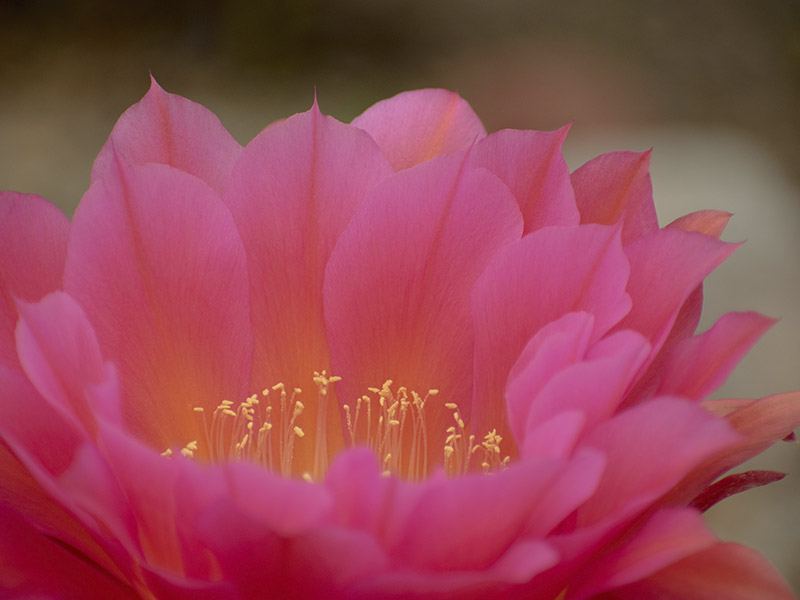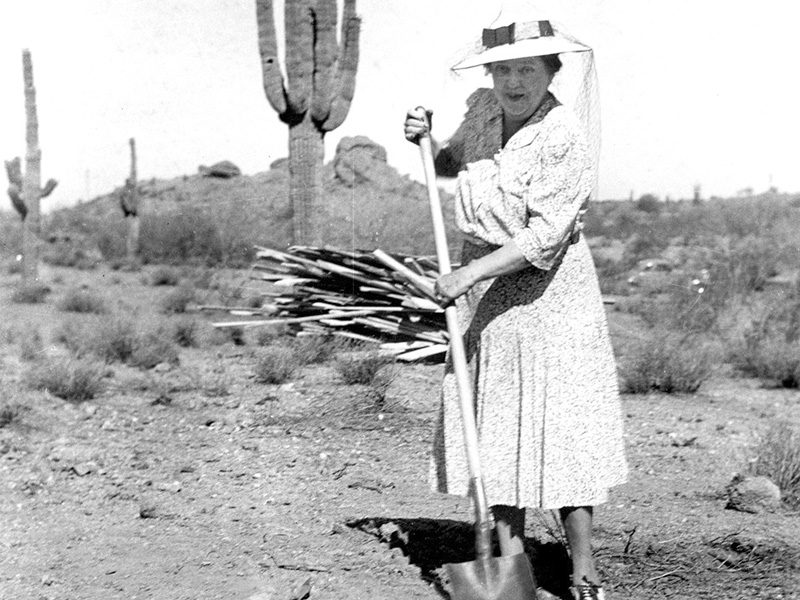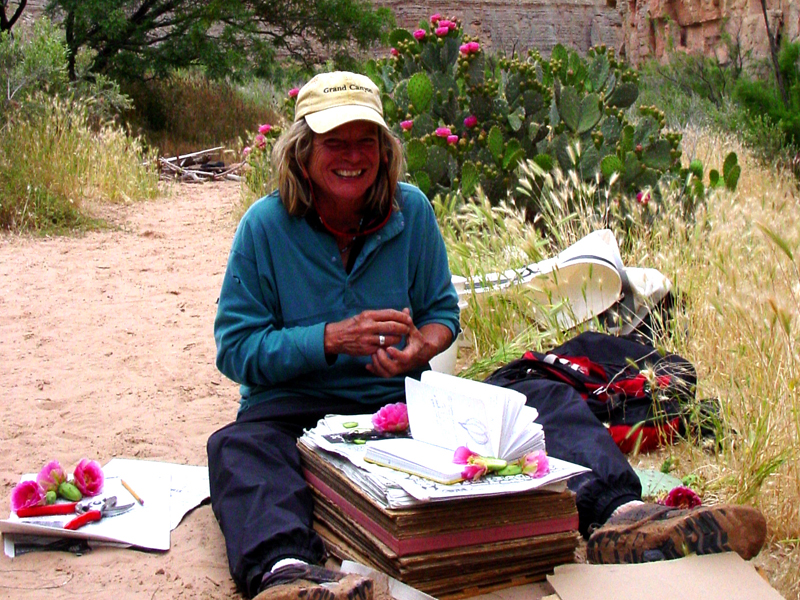Feminine Nature
Nora Burba Trulsson
Read more from the Fall 2019 Sonoran Quaterly, 80th Anniversary issue to learn about women who have made history at the Garden.
Through the years, strong women have shaped Desert Botanical Garden.
More than ever, women and the women’s movement have been in the headlines, but at Desert Botanical Garden, women have always been important in shaping the Garden’s form and future. From its founder and an executive director to its dedicated cadre of indefatigable volunteers, women have helped the Garden grow. Here are just a few of the ladies who launch.
GERTRUDE DIVINE WEBSTER
The Garden’s founder, Gertrude Divine Webster, was no shrinking violet. Fond of smoking small cigars and wearing heavy perfume, Illinois-born Webster married and divorced well, negotiating millions of dollars in a settlement—not to mention half the liquor—when she divorced in 1922, according to research done by Garden volunteer Ron Lieberson. The money allowed Webster to pursue her interests, including building a winter home in Phoenix at the base of Camelback Mountain in the late ’20s and engaging in land speculation in what is now the Arcadia neighborhood. After purchasing some rare cactus, she came in contact with Gustaf Starck, a self-taught botanist and founder of the Arizona Cactus and Native Flora Society, whose ambition was to start a botanical garden dedicated to plants of the desert. The rest, they say, is history. Webster joined the society and enthusiastically took on the cause of launching the garden, recruiting Phoenix movers and shakers to the cause, donating her own money and plants, and enlisting Charles Gibbs Adams, a landscape architect, to design the site at Papago Park. Webster also hired the Garden’s first director, George Lindsay, and helped fund the Garden’s first building, the Pueblo Revival-style Webster Auditorium, which is still in use today. She oversaw the Garden’s opening in 1939, but ill health in the ensuing years confined her to her Camelback home. She passed away in 1947, at the age of 75.
WENDY HODGSON
When she’s not at the Garden, it’s likely you’ll find Wendy Hodgson backpacking through the Grand Canyon and the rest of Arizona, in pursuit of its flora. The New York native and avid plant collector has the perfect job—she’s the Garden’s herbarium curator emerita and senior research botanist, who has personally collected some 32,000 of the herbarium’s 89,000 specimens. Initially hired as an illustrator, Hodgson came to the Garden in 1974, armed with a freshly minted ASU bachelor’s degree in wildlife biology. The job soon morphed into a little bit of everything, with Hodgson driving tractors and putting up fences before being encouraged to go out into the field to find and collect plants for the herbarium. This led to her pursuing and receiving a master’s degree in botany in 1982. Hodgson, though, isn’t always out in the desert with a knife and a notepad. She’s also an adjunct professor of conservation biology at ASU and has authored “Food Plants of the Sonoran Desert” (2001, University of Arizona Press), which won a Klinger Book Award given by the Society for Economic Botany. More recently, in conjunction with fellow curator and researcher Andrew Salywon and Archaeology Southwest, she was instrumental in discovering a new species of domesticated agave—Agave sanpedroensis—in Southern Arizona, cultivated by ancient farmers.
“Being a scientist is a humbling profession,” Hodgson says. “I feel so lucky to have stumbled into my passion.”
CAROLYN POLSON O’MALLEY
One night when Carolyn Polson O’Malley was first working at the Garden, she left her office late, meandering down a path illuminated only by a full moon. “I leaned down to pick up a hose off the path,” recalls the Garden’s former executive director, “and the hose moved. I quickly learned it was Connie, the king snake.” O’Malley didn’t know much about botany (or reptiles, for that matter) when she first came to the Garden as assistant director in 1994, but she did have a strong background in volunteer work and management. The Phoenix native earned her master’s in international management from what is now the Thunderbird School of Global Management, lived overseas for many years and had a background in nonprofit management before joining the Garden. During her tenure, the Garden grew substantially, thanks, she says, to a strong staff, volunteer group and board, plus a capital campaign that resulted in the funds to construct Dorrance Hall, the Marley Education and Volunteer Building, the Nina Mason Pulliam Desert Research and Horticulture Center and other facilities. Since leaving the Garden, O’Malley served as executive director of the Dorrance Family Foundation—from which she recently retired—and has remained an active volunteer, serving as a member of the Board of Trustees and on many boards.
“I was so lucky to have worked at the Garden,” she reflects. “It’s a magical environment that captured my heart.”
HAZEL HARE
Hazel Hare had a love of learning. It’s a quality that served her well when curiosity about desert plants led her to involvement at the Garden in the 1970s and a desire to figure out ways to help the organization steered her toward joining the Garden’s board of trustees in 1994. Hare was born in Brooklyn in 1931, says her niece, Tracey Kane, and received a degree in chemistry from Montreal’s McGill University. In the 1950s, she married Donald Hare, who founded a California manufacturing company that specialized in television broadcasting and sound equipment. When the company was sold in the 1970s, the Hares took up flying, which landed them in the Phoenix area for the favorable aviation weather.
“My aunt was unfamiliar with desert plants when they first moved here,” recalls Kane. “So she took a class and fell in love with the Garden.” Hare threw herself into work for the Garden, joining committees, spearheading a capital campaign that raised millions of dollars and generously donating (always anonymously) her own money to help causes. She also became active in other organizations, including the Arizona Science Center. Hare passed away in 2016. The Garden’s Hazel Hare Center for Plant Science is named in her honor. “She would never accept recognition when she was alive,” says Kane, “but she was an active ‘doer.’ She deserves to be recognized for what she did.”
HELEN WOODEN
For years, volunteer Helen Wooden was a fixture at the Garden, tooling around the winding paths on her scooter and chatting up guests, imparting her love of the desert and its plants. “Helen was our “rolling ambassador,’” recalls Ken Schutz, the Garden’s executive director. “We often received notes and letters from visitors who told us how much they enjoyed talking to her.” Born in Ohio of Hungarian descent and raised on a farm during the Depression, Wooden contracted polio as a youth, but never let that slow her down. According to Schutz, she worked as a teacher in Ohio, then took a bus to come to Phoenix, seeking sunshine and adventure. She had a career teaching elementary school in the Phoenix area and in Superior, married and raised a family. After her husband passed away, Wooden joined the Garden in 1999, driving herself in a van specially equipped for her scooter and never letting her disability affect her fierce independence and love of the desert, which she shared with everyone. “She was here almost every day,” says Schutz. “She was an institution.” After Wooden passed away in 2015, with the support of her family, the Garden erected a memorial bench in her honor, located in the Kitchell Family Heritage Garden—one of her favorite spots.
CARMEN DE NOVAIS GUERRERO
Carmen de Novais Guerrero usually works behind the scenes, where she has curated the annual Día de los Muertos Celebration weekend at the Garden for the past 14 years. She reaches out to local artists to create the ofrenda, or offering altars, and to local performers who engage audiences with storytelling, music and dance that tell the story of the Latino Day of the Dead traditions. But beyond her work at the Garden, Guerrero is a cultural polymath, someone who is well known and well connected to the Valley’s art scene. She’s a musician who studied piano at Oberlin College and also plays guitar and accordion, an organizer who puts together festivals around the city and an artist who handcrafts beaded jewelry inspired by traditional motifs of her native Brazil. She’s also part of an artistic family, married to Zarco Guerrero, a sculptor, performance artist and fellow musician (their Latin-Caribbean band, Zum Zum Zum, was a popular fixture in Arizona during the 1980s and ‘90s), and mother to three children, who are also artists and musicians. “We have a commitment to the community,” says Guerrero of her work, and her family’s efforts to bring art and culture to the Garden. “The Garden is ancient ancestral land. It’s an inspirational and beautiful place for us.”
About Women’s History Month
Women’s History Month began in 1981 when Congress passed Pub. L. 97-28 which authorized and requested the President to proclaim the week beginning March 7, 1982 as “Women’s History Week. Between 1988 and 1994, Congress passed additional resolutions requesting and authorizing the President to proclaim March of each year as Women’s History Month. Since 1995, presidents have issued a series of annual proclamations designating the month of March as “Women’s History Month.” These proclamations celebrate the contributions women have made to the United States and recognize the specific achievements women have made over the course of American history in a variety of fields.
Read more from our Fall 2019 Sonoran Quaterly, 80th Anniversary issue to learn about women who have made history at the Garden






